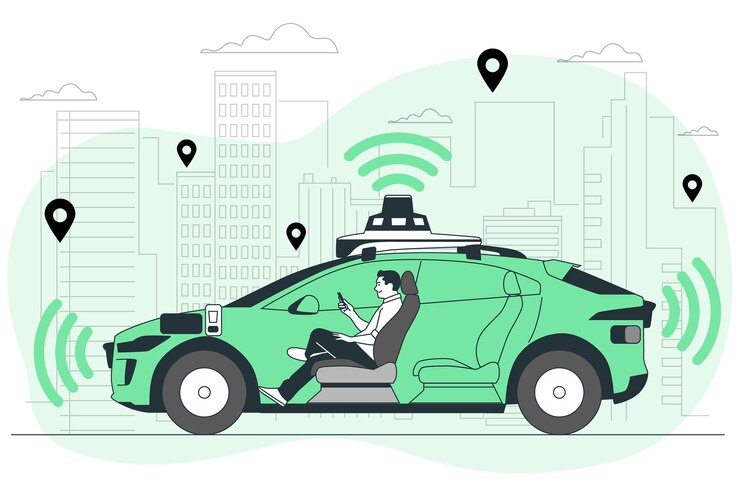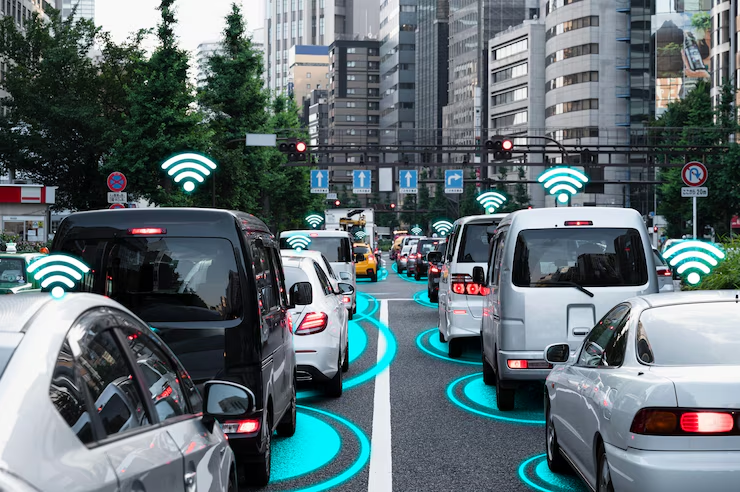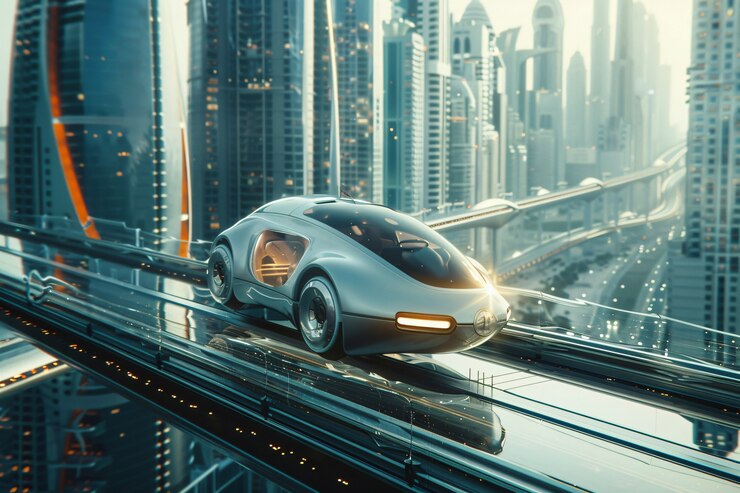Introduction: The Rise of Self-Driving Cars
The self-driving car is no longer a futuristic dream—it’s becoming a reality, revolutionizing the way we think about transportation, road safety, and urban mobility. Powered by artificial intelligence (AI), machine learning, and advanced sensor technology, autonomous vehicles are set to reshape industries, improve traffic efficiency, and significantly reduce road accidents caused by human error.
From tech giants like Tesla, Google’s Waymo, and Apple to traditional automakers like Mercedes-Benz and BMW, companies worldwide are racing to develop the next generation of self-driving cars. With advancements in LiDAR, radar, and real-time data processing, autonomous vehicles are now smarter, safer, and more capable than ever before.
Why Self-Driving Cars Matter?
- Enhanced Road Safety: AI-powered autonomous vehicles reduce the risk of accidents caused by distracted driving, fatigue, and speeding.
- Traffic Optimization: Smart navigation and vehicle-to-vehicle (V2V) communication help ease congestion and improve fuel efficiency.
- Sustainability & Eco-Friendliness: With optimized driving patterns, self-driving cars can significantly lower carbon emissions.
- Mobility for All: Autonomous cars provide greater accessibility for disabled individuals, elderly citizens, and those unable to drive.
Despite these promising advancements, challenges such as regulatory concerns, ethical dilemmas, and cybersecurity risks still need to be addressed before self-driving technology becomes mainstream. However, with continuous innovation and investment, autonomous driving is poised to transform the global automotive landscape.
1. Explore the History and Evolution of Self-Driving Cars
The journey of the self-driving car is a fascinating tale of innovation, ambition, and technological breakthroughs. While autonomous vehicle technology might seem like a product of the 21st century, the dream of driverless transport dates back over a century. From early concepts to the AI-driven autonomous vehicles of today, the evolution of self-driving cars has been a mix of steady progress, bold experimentation, and groundbreaking advancements.
The Early Vision: Conceptualizing Autonomous Vehicles
The idea of automated driving was first introduced in the early 20th century. In 1925, Francis Houdina, an American engineer, demonstrated a radio-controlled car in New York City, proving that vehicles could operate without human intervention. Though basic in functionality, this early prototype ignited the vision of a driverless future.
By the 1950s and 1960s, General Motors (GM) experimented with automated highway systems, introducing the idea of self-steering cars that could follow embedded wires on the road. While these projects never reached mass production, they laid the foundation for future autonomous vehicle technology.
The Digital Revolution: The 1980s – 2000s
The true breakthroughs in self-driving technology emerged in the 1980s, thanks to advancements in computer vision, artificial intelligence (AI), and sensor technology.
- 1980s: The first major attempt at autonomous driving came from Carnegie Mellon University (CMU), where researchers developed the NavLab, a vehicle equipped with cameras and processors to detect its surroundings.
- 1994: Mercedes-Benz, in collaboration with the EUREKA Prometheus Project, successfully tested an autonomous vehicle on European highways, demonstrating early versions of computer-controlled driving.
- 2000s: Google (later Waymo), Tesla, and other tech giants began developing AI-powered self-driving car systems, integrating LiDAR, radar sensors, and machine learning algorithms to improve autonomous navigation.
The AI-Driven Era: The 2010s – Present
The 2010s marked the true rise of self-driving cars, with significant advancements in deep learning, AI, and real-time data processing. Companies like Tesla, Waymo, Uber, and Apple made autonomous driving technology a priority, investing billions into AI-powered self-driving systems.
- 2015: Tesla introduced its Autopilot feature, making semi-autonomous driving available to consumers.
- 2016: Uber launched self-driving taxis in Pittsburgh, signaling a shift in autonomous vehicle applications.
- 2020s: Fully autonomous vehicles, like Waymo’s self-driving taxis, began operating without human intervention in select cities, proving that the future of driverless cars was no longer a dream but a reality.
The Road Ahead: Where Are We Now?
Today, the race to perfect self-driving technology continues, with major companies and governments investing heavily in AI-powered autonomous vehicles. While full-scale adoption is still facing regulatory, ethical, and cybersecurity challenges, the rapid growth of AI, 5G, and smart transportation is making a future dominated by self-driving cars inevitable.
2. Explore How Self-Driving Cars Work: The Technology Behind It

The self-driving car is not just a vehicle—it’s an intelligent machine that relies on cutting-edge artificial intelligence (AI), machine learning, and real-time data processing to navigate roads safely. Unlike traditional vehicles that require human input, autonomous vehicles analyze their surroundings, predict traffic behavior, and make split-second driving decisions—all without a human driver. But how do they achieve this level of precision and reliability?
Key Technologies Behind Self-Driving Cars
A self-driving car relies on a combination of hardware and software to perceive its environment, process data, and make driving decisions. Below are the key components that make autonomous driving possible:
1. Advanced Sensors: The Eyes and Ears of an Autonomous Car
For a self-driving car to navigate safely, it must first understand its surroundings. This is achieved through a combination of sensors that continuously collect real-time data:
LiDAR (Light Detection and Ranging):
- Uses laser beams to create a 3D map of the car’s environment.
- Helps detect pedestrians, vehicles, and obstacles with high accuracy.
Radar Sensors:
- Detects objects in different weather conditions (rain, fog, snow).
- Measures the speed and distance of surrounding vehicles.
Cameras & Computer Vision:
- Identifies traffic signals, lane markings, road signs, and pedestrians.
- Works in combination with deep learning algorithms to interpret visual data.
Ultrasonic Sensors:
- Primarily used for low-speed maneuvers like parking and close-range object detection.
2. AI and Machine Learning: The Brain of the Self-Driving Car
Once the sensors collect raw data, the AI-powered onboard computer processes it to make intelligent driving decisions.
Neural Networks & Deep Learning:
- AI models are trained on vast amounts of driving data to recognize patterns and predict road conditions.
- Enables the car to distinguish between pedestrians, cyclists, vehicles, and road signs.
Path Planning Algorithms:
- Determines the safest and most efficient route for the vehicle.
- Considers real-time traffic conditions, weather, and potential hazards.
Predictive Analytics:
- Anticipates the movements of other vehicles and pedestrians to prevent accidents.
- Enhances decision-making for complex scenarios (e.g., merging onto highways, roundabouts).
3. Connectivity & Real-Time Data Processing
Self-driving technology relies heavily on seamless connectivity to ensure efficient decision-making.
GPS & High-Definition Maps:
- Autonomous vehicles use precise GPS tracking combined with high-definition maps for navigation.
- Helps the car understand its exact position on the road.
5G & V2X Communication (Vehicle-to-Everything):
- Enables self-driving cars to communicate with other vehicles, traffic signals, and road infrastructure.
- Enhances real-time data sharing, improving safety and coordination.
Cloud Computing & Edge Processing:
- Autonomous vehicles leverage cloud computing to process vast amounts of data in real-time.
- Allows continuous updates on road conditions, traffic congestion, and route optimization.
4. Decision-Making & Autonomous Control Systems
Once a self-driving car processes environmental data, it must execute driving actions just like a human driver. This involves:
Adaptive Cruise Control (ACC):
- Adjusts the car’s speed based on surrounding traffic.
Lane-Keeping Assistance & Automated Steering:
- Ensures the vehicle stays within lane markings.
- Detects and responds to road curves and turns.
Braking & Collision Avoidance Systems:
- Predicts potential accidents and applies brakes if necessary.
- Uses emergency braking to prevent collisions with pedestrians or obstacles.
Autonomous Parking & Summoning:
- Self-parking capabilities allow the car to park itself without human intervention.
- Some vehicles can even be summoned remotely using smartphone apps.
3. Explore The Levels of Autonomous Driving
The journey toward fully autonomous vehicles is not an overnight revolution but an evolutionary process that involves multiple stages of technological advancements. Self-driving cars are classified into different levels based on their ability to operate without human intervention. These levels of autonomous driving, defined by the Society of Automotive Engineers (SAE), range from Level 0 (no automation) to Level 5 (full autonomy).
Understanding these levels is crucial for businesses, investors, and consumers looking to embrace autonomous vehicle technology in the coming years.
The 6 Levels of Autonomous Driving
The SAE automation scale consists of six distinct levels (0–5), each representing an increasing degree of self-driving capability.
Level 0: No Automation (Human-Driven Cars)
At this level, self-driving technology is nonexistent. The driver controls everything, including steering, acceleration, and braking. Some vehicles may feature basic driver assistance systems like lane departure warnings and emergency braking, but the human driver remains fully responsible.
- Examples: Traditional cars with no autonomous features.
Level 1: Driver Assistance (Basic Automation)
At Level 1, vehicles introduce semi-autonomous features that assist drivers but do not take full control. The car may have adaptive cruise control or lane-keeping assist, but the driver must remain engaged at all times.
- Examples:
- Tesla’s Traffic-Aware Cruise Control
- Mercedes-Benz’s Lane-Keeping Assist
Level 2: Partial Automation (Advanced Driver Assistance Systems – ADAS)
Level 2 introduces more sophisticated self-driving technology, where the vehicle can control both steering and acceleration simultaneously. However, the driver must stay alert and ready to take over at any moment.
Features of Level 2 Automation:
- Adaptive Cruise Control (Automatically adjusts speed based on traffic)
- Lane-Centering Assistance (Keeps the car in its lane)
- Automated Emergency Braking (Detects and prevents collisions)
- Examples:
- Tesla Autopilot
- GM’s Super Cruise
- Ford’s BlueCruise
Level 3: Conditional Automation (Hands-Off, Eyes-On)
Level 3 marks a major shift in self-driving technology, where the car can make decisions independently under specific conditions. The driver does not need to keep their hands on the wheel but must be ready to intervene if required.
Features of Level 3 Automation:
- Traffic Jam Assist (Handles stop-and-go traffic autonomously)
- Highway Driving Automation (Car can change lanes and overtake slower vehicles)
- AI-Powered Decision Making (Can detect and react to real-world scenarios)
- Examples:
- Mercedes-Benz Drive Pilot (First Level 3-certified system for public roads)
- Honda Legend (Japan’s First Level 3 Car)
Limitation: Works only in pre-defined conditions (e.g., highways with minimal complexity).
Level 4: High Automation (Hands-Off, No Human Supervision in Certain Areas)
At Level 4, self-driving cars become almost fully autonomous. They can operate without human input in geofenced locations (e.g., specific cities, highways, or ride-hailing zones). The vehicle does not require a human driver but may include manual controls as an option.
Features of Level 4 Automation:
- Fully Autonomous in Geofenced Areas (No human required in mapped regions)
- Robotaxis & Self-Driving Shuttles (Public transport without drivers)
- Remote Monitoring & AI-Based Decision Making
- Examples:
- Waymo’s Fully Autonomous Robotaxi Service (Arizona, USA)
- Baidu Apollo (China’s Self-Driving Taxis)
Limitation: These vehicles still require predefined routes and may not work in extreme weather or high-risk environments.
Level 5: Full Automation (No Human Intervention at All)
Level 5 represents the ultimate vision of self-driving cars—a world where vehicles operate without steering wheels, pedals, or any human involvement. These cars can drive anywhere, under any conditions, just like a highly skilled human driver.
Features of Level 5 Automation:
- No Human Driver Required (Complete autonomy in all environments)
- AI-Powered Self-Driving in Any Weather & Traffic Conditions
- Full Integration with Smart Cities & IoT Connectivity
- Future Examples (Not yet commercially available):
- Tesla’s Fully Autonomous Robotaxi Vision
- Apple’s Secretive Self-Driving Car Project
- Google’s Next-Gen AI-Powered Autonomous Vehicles
Limitation: As of today, no vehicle has achieved Level 5 autonomy due to regulatory, ethical, and technological barriers.
What’s Next for Autonomous Driving?
As autonomous vehicle technology continues to evolve, the race toward Level 5 automation is intensifying. However, challenges such as regulatory approvals, public trust, and infrastructure development still need to be addressed before self-driving cars become mainstream.
4. Explore the Benefits of Self-Driving Cars
The rise of self-driving cars marks one of the most revolutionary advancements in automotive technology. With autonomous vehicles rapidly evolving, they promise to reshape the future of transportation, road safety, and urban mobility. From reducing traffic congestion to enhancing fuel efficiency, the benefits of autonomous driving technology are extensive and far-reaching.
1. Enhanced Road Safety: Reducing Human Errors
One of the most significant advantages of autonomous vehicles is the drastic reduction in road accidents. Studies indicate that 94% of traffic accidents are caused by human errors such as:
- Distracted driving (texting, eating, or adjusting the radio)
- Drunk driving (impaired judgment and slow reaction times)
- Fatigue (falling asleep behind the wheel)
By eliminating human mistakes, self-driving cars—powered by AI, machine learning, and LiDAR technology—can react faster, predict dangers, and prevent fatal crashes. Tesla’s Autopilot and Waymo’s autonomous systems have already demonstrated improved collision avoidance capabilities.
2. Reduced Traffic Congestion and Smoother Traffic Flow
Traffic congestion is a major issue in urban cities, costing billions in lost productivity and fuel consumption. Self-driving cars can:
- Communicate with smart traffic systems to optimize traffic flow
- Use AI-powered route optimization to avoid congested areas
- Maintain consistent speeds and safe distances, reducing bottlenecks
With widespread adoption of autonomous vehicles, traffic jams could become a thing of the past, leading to faster commute times and lower emissions.
3. Environmental Benefits: Lower Carbon Footprint
Electric self-driving cars are set to revolutionize sustainable transportation by:
- Reducing fuel consumption through efficient driving algorithms
- Lowering greenhouse gas emissions by eliminating unnecessary acceleration and braking
- Encouraging electric vehicle (EV) adoption, making cities greener
Companies like Tesla, Waymo, and General Motors are already leading the transition toward fully electric, autonomous fleets, which can help combat climate change.
4. Economic Growth and Productivity Gains
The introduction of self-driving technology could boost the global economy by:
- Lowering transportation costs for businesses and consumers
- Increasing productivity—commuters can work or relax instead of driving
- Creating new jobs in AI, software engineering, and automotive tech
Industries such as logistics, ride-sharing, and delivery services stand to gain the most, as autonomous trucking and self-driving taxis reduce labor costs and improve efficiency.
5. Greater Mobility for Elderly and Disabled Individuals
For individuals with disabilities or elderly citizens who are unable to drive, autonomous cars offer newfound freedom and accessibility.
- Self-driving taxis could provide on-demand transportation for senior citizens
- AI-powered navigation helps visually impaired passengers travel safely
- Automated parking and accessibility features enhance independence
Companies like Waymo and Uber are working on self-driving ride-hailing services that cater specifically to people with mobility challenges.
6. More Efficient Urban Planning and Smart Cities
With autonomous vehicles, cities can be designed with:
- Smaller parking spaces, freeing up real estate for parks and housing
- Optimized traffic patterns, reducing road expansions
- Better public transportation integration, making commuting seamless
As smart cities continue to develop, self-driving technology will play a key role in shaping the future of urban mobility.
7. Revolutionizing the Logistics and Delivery Industry
The self-driving revolution is set to transform logistics and supply chain management.
- Autonomous trucks can operate 24/7, reducing delivery times and costs
- Self-driving delivery drones and bots can enhance last-mile delivery
- AI-powered fleet management optimizes fuel efficiency and cargo handling
Companies like Amazon, Tesla, and FedEx are already investing in autonomous logistics to streamline supply chains and cut operational expenses.
The Future of Self-Driving Cars: What’s Next?
As autonomous vehicle technology continues to evolve, it’s clear that self-driving cars offer enormous benefits across industries. However, challenges such as regulations, ethical concerns, and cybersecurity risks still need to be addressed before full-scale adoption.
5. Explore Challenges and Limitations of Autonomous Vehicles
Despite the groundbreaking advancements in self-driving car technology, widespread adoption of autonomous vehicles (AVs) still faces significant challenges. While these vehicles promise safer roads, reduced congestion, and environmental benefits, there are technological, legal, ethical, and economic hurdles that must be addressed before fully autonomous cars become the norm.
1. Safety and Reliability Concerns
One of the biggest challenges for autonomous vehicle technology is ensuring 100% reliability in all driving conditions. While AI-powered self-driving systems have shown impressive accident prevention capabilities, they still struggle with:
- Unpredictable human behavior—reacting to aggressive or reckless drivers
- Adverse weather conditions—heavy rain, fog, or snow can interfere with sensors
- Complex urban environments—navigating through crowded streets and pedestrians
Even the most advanced AI driving systems, such as Tesla’s Autopilot and Waymo’s autonomous technology, have encountered fatal accidents, raising concerns about their readiness for real-world deployment. Public trust and safety regulations remain major hurdles in achieving full autonomy.
2. Legal and Regulatory Challenges
The introduction of self-driving cars has raised complex legal and regulatory questions, such as:
- Who is liable in case of an accident—the manufacturer, the AI, or the owner?
- How can governments ensure consistent safety standards for AVs?
- Should self-driving cars be allowed on all roads, or only specific areas?
Different countries have different approaches to autonomous vehicle regulations. While the U.S., Europe, and China are making progress in establishing AV-friendly policies, most governments remain cautious, delaying mass adoption.
Additionally, data privacy laws are a growing concern, as self-driving vehicles collect vast amounts of personal and location data. Ensuring cybersecurity and preventing hacking threats is critical for widespread acceptance.
3. Ethical Dilemmas in AI Decision-Making
Autonomous vehicles operate based on machine learning algorithms, but AI lacks human morality. This raises ethical questions about decision-making in life-and-death situations.
For example:
- If a self-driving car must choose between hitting a pedestrian or crashing itself, what decision should the AI make?
- Should AVs prioritize passenger safety over others on the road?
- Who is responsible when AI makes a morally controversial decision?
These ethical dilemmas pose challenges for AI programming and require universal ethical frameworks for autonomous driving systems.
4. High Costs of Development and Implementation
Developing fully autonomous vehicles involves expensive R&D, AI training, and sensor technology. The cost of implementing:
- LIDAR (Light Detection and Ranging) sensors for mapping surroundings
- Advanced AI and machine learning models for real-time decision-making
- High-speed computing systems for processing vast amounts of data
These technologies make self-driving cars extremely expensive, limiting their affordability for the general public. Companies like Tesla, Waymo, and Uber are working to reduce costs, but it may take years before AVs become widely affordable.
5. Infrastructure Challenges: Are Our Roads Ready?
For autonomous vehicles to function seamlessly, cities need smart infrastructure with:
- Digitized traffic signals and real-time road updates
- Dedicated lanes for self-driving cars
- 5G-powered vehicle-to-vehicle (V2V) and vehicle-to-infrastructure (V2I) communication
However, most global road systems lack these capabilities, making it difficult for self-driving cars to operate efficiently. Developing AV-friendly infrastructure requires significant investment from both governments and private sectors.
6. Cybersecurity Risks: Protecting Autonomous Vehicles from Hacking
Since self-driving cars rely on AI, cloud computing, and internet connectivity, they are vulnerable to cybersecurity threats. Potential risks include:
- Hacking into vehicle control systems, leading to dangerous outcomes
- Data breaches, compromising user privacy and location tracking
- Malware attacks that could disable or hijack self-driving fleets
Ensuring robust cybersecurity measures, such as end-to-end encryption and AI-driven threat detection, is crucial to prevent cyberattacks on AVs.
7. Job Displacement in the Transportation Industry
While self-driving cars bring efficiency, they also threaten millions of jobs in industries such as:
- Taxi and ride-hailing services—Uber and Lyft drivers may become obsolete
- Truck drivers—Autonomous freight trucks could replace human operators
- Delivery services—Self-driving robots and drones could eliminate courier jobs
Although new jobs will emerge in AI engineering, cybersecurity, and AV maintenance, retraining workers will be necessary to address job displacement concerns.
Overcoming These Challenges: The Future of Autonomous Vehicles
Despite these obstacles, the future of self-driving technology remains promising. Companies, governments, and AI researchers are continuously working on advancing autonomous systems, enhancing safety, and creating regulations that ensure a seamless transition to self-driving transportation.
6. Explore The Role of AI and Machine Learning in Autonomous Driving

The success of self-driving cars largely depends on artificial intelligence (AI) and machine learning (ML), which enable these vehicles to interpret their surroundings, make decisions, and drive safely without human intervention. AI is the brain behind autonomous vehicles, allowing them to navigate complex road conditions, avoid obstacles, and respond dynamically to real-world scenarios.
1. AI-Powered Perception: Understanding the Environment
For a self-driving car to operate safely, it must see, analyze, and react to everything around it in real time. This is achieved through:
- Computer Vision – AI-powered cameras detect road signs, lane markings, pedestrians, and other vehicles.
- LIDAR (Light Detection and Ranging) – Uses laser sensors to create a 3D map of the car’s surroundings.
- Radar and Ultrasonic Sensors – Detects nearby objects, vehicles, and distances for safe navigation.
AI processes this data in milliseconds, ensuring the vehicle can react to sudden obstacles, traffic signals, and unexpected hazards—just like a human driver would.
2. Machine Learning for Decision-Making and Navigation
While traditional cars rely on pre-programmed rules, autonomous vehicles use machine learning (ML) to learn from experience and continuously improve their driving skills.
- Deep Learning Algorithms – These models help self-driving cars recognize objects, predict traffic patterns, and improve over time.
- Reinforcement Learning – The AI learns by trial and error, optimizing its driving behavior based on real-world scenarios.
- Neural Networks – Inspired by the human brain, these AI systems process complex driving environments and enhance decision-making.
By leveraging big data and AI-powered simulations, autonomous vehicles become smarter with every mile they drive, making them safer and more efficient over time.
3. Path Planning and Real-Time Adaptation
AI-powered path planning systems help self-driving cars decide the safest and most efficient routes by considering:
- Traffic flow and congestion levels
- Traffic signals and stop signs
- Weather conditions affecting road safety
- Road construction and detours
This ensures that the vehicle adapts dynamically to road conditions, avoiding delays and reducing the risk of accidents.
4. AI for Collision Avoidance and Safety Measures
One of the most crucial aspects of autonomous driving is collision prevention. AI integrates:
- Predictive Analytics – Anticipates potential collisions and applies brakes or adjusts speed accordingly.
- Adaptive Cruise Control (ACC) – Maintains a safe distance from other vehicles by adjusting speed automatically.
- Automatic Emergency Braking (AEB) – AI detects sudden obstacles and applies brakes to prevent crashes.
- Lane-Keeping Assistance – Prevents the vehicle from drifting out of its lane.
These AI-driven safety features drastically reduce human errors, which are responsible for over 90% of road accidents worldwide.
5. AI and Vehicle-to-Everything (V2X) Communication
To achieve full autonomy, self-driving cars must communicate with:
- Other Vehicles (V2V) – Sharing real-time speed, location, and traffic data.
- Infrastructure (V2I) – Interacting with traffic signals, road sensors, and toll systems.
- Cloud-Based AI (V2C) – Accessing weather updates, traffic reports, and high-definition maps.
This AI-powered network enables self-driving cars to make informed decisions, optimize routes, and enhance overall driving efficiency.
6. AI in Cybersecurity: Protecting Autonomous Vehicles
Since self-driving cars rely on internet connectivity, they are vulnerable to cybersecurity threats such as:
- Hacking attacks – Malicious entities could take control of AV systems.
- Data breaches – Personal and location data could be compromised.
- System failures – Cyberattacks could disrupt vehicle operations.
To counter these risks, AI-driven cybersecurity solutions use real-time threat detection, encryption, and AI-powered firewalls to protect autonomous vehicles from digital threats.
The Future of AI in Autonomous Driving
The role of AI and machine learning in self-driving cars will only expand in the coming years. With advancements in deep learning, quantum computing, and AI-powered simulations, we can expect:
- More human-like decision-making abilities in self-driving cars
- Safer and more reliable AI-driven transportation systems
- Wider adoption of autonomous ride-sharing services and robo-taxis
- Upcoming breakthroughs in autonomous vehicle technology
- When we can expect full-scale adoption of self-driving cars
- How AI will shape the future of transportation
7. Explore Major Companies Developing Self-Driving Car Technology

The race to create fully autonomous vehicles is heating up, with some of the world’s biggest tech companies and automakers investing billions in self-driving car technology. These industry leaders are pushing the boundaries of artificial intelligence (AI), machine learning (ML), and advanced sensor technology to make autonomous driving a reality.
1. Tesla: The Pioneer of Autonomous Driving
- Key Technologies: Autopilot, Full Self-Driving (FSD), Neural Networks
- Vision: Fully autonomous electric vehicles (EVs) with AI-powered self-learning systems
Tesla is one of the most recognized names in the self-driving car industry, thanks to its Autopilot and Full Self-Driving (FSD) package. Using computer vision, deep learning, and real-time data processing, Tesla’s AI-powered neural networks continuously improve the driving capabilities of its vehicles.
- Real-time over-the-air updates to enhance autonomous capabilities
- Advanced driver-assistance system (ADAS) with automated lane changes, braking, and navigation
- Tesla Vision – a camera-based system that eliminates LIDAR dependency
Tesla’s self-driving technology is among the most advanced in the world, bringing us closer to a future where electric and autonomous vehicles dominate the roads.
2. Waymo: Google’s Self-Driving Car Revolution
- Key Technologies: LIDAR, AI-powered perception, Ride-hailing Robo-Taxis
- Vision: Driverless ride-sharing and fully autonomous taxis
Waymo, a subsidiary of Alphabet (Google’s parent company), is a leader in the autonomous vehicle industry. With over 20 million miles of real-world driving experience, Waymo’s self-driving cars operate in major cities like Phoenix and San Francisco through its Waymo One ride-hailing service.
- LIDAR-powered 360-degree vision system for precise navigation
- AI-driven deep learning models that predict pedestrian and vehicle movements
- Fleet of fully autonomous robo-taxis already in operation
Waymo’s focus on safety, scalability, and real-world application makes it a game-changer in the autonomous mobility sector.
3. Apple: The Secretive Titan in Autonomous Driving
- Key Technologies: AI-powered self-driving systems, LIDAR, AR Integration
- Vision: Revolutionizing the automotive industry with an Apple-branded autonomous EV
Apple’s Project Titan has been a closely guarded secret, but reports indicate that Apple is developing an AI-driven, fully electric self-driving car.
- Advanced AI and machine learning algorithms for predictive driving
- Potential partnership with major car manufacturers for production
- Seamless integration with Apple’s ecosystem for next-gen user experience
While details remain confidential, Apple’s track record of disrupting industries suggests that its autonomous car project could redefine transportation.
4. General Motors (GM) & Cruise: The Future of Urban Mobility
- Key Technologies: Super Cruise, AI-driven robo-taxis, EV integration
- Vision: Autonomous ride-sharing services and smart city transportation
GM’s Cruise division is making significant strides in the self-driving industry, focusing on electric and autonomous taxis to revolutionize urban transportation.
- Super Cruise – hands-free highway driving technology
- AI-powered decision-making for complex city driving
- Fully autonomous ride-hailing services in cities like San Francisco
With strong backing from Honda and Microsoft, Cruise aims to make self-driving cars mainstream.
5. NVIDIA: Powering the AI Revolution in Autonomous Vehicles
- Key Technologies: Deep Learning AI, Autonomous Vehicle Computing, Digital Twin Simulation
Vision: Providing cutting-edge AI hardware and software for self-driving cars
NVIDIA may not build cars, but its AI-driven computing platforms power most of the autonomous vehicle industry.
- NVIDIA Drive – an AI-powered self-driving platform
- Deep learning neural networks for real-time driving decisions
- Simulated environments for testing and training AI models
With partners like Mercedes-Benz, Volvo, and Toyota, NVIDIA’s AI technology is a cornerstone of the self-driving revolution.
6. Other Key Players in the Autonomous Driving Space
- Ford & Argo AI – Developing AI-powered autonomous taxis and delivery vehicles.
- Mercedes-Benz – Introducing Level 3 self-driving technology with Drive Pilot.
- Uber ATG (Now Aurora) – Working on self-driving ride-sharing and freight transport.
- Baidu Apollo – Leading China’s self-driving car industry with AI and V2X communication.
The Future of Self-Driving Car Companies
The competition to develop safe, scalable, and commercially viable autonomous vehicles is intensifying. With rapid advancements in AI, machine learning, and automotive innovation, the world is on the brink of a driverless transportation revolution.
As we move forward, collaborations between tech giants, automakers, and AI researchers will accelerate the adoption of self-driving cars, making roads safer, reducing traffic congestion, and transforming how people and goods move.
8. Explore Global Regulations and Policies on Autonomous Vehicles

The rapid development of self-driving cars has brought both excitement and concern to policymakers worldwide. As autonomous vehicle technology advances, governments and regulatory bodies are working to establish comprehensive laws and safety standards to ensure the smooth integration of driverless cars into existing transportation systems.
The Global Legal Framework for Autonomous Vehicles
Countries around the world are taking different approaches to regulating self-driving cars, with some leading the charge in creating autonomous vehicle-friendly laws, while others remain cautious.
United States: Pioneering Autonomous Vehicle Regulations
The U.S. is one of the most progressive markets for autonomous driving technology, with several states allowing extensive testing and deployment of self-driving cars.
- National Highway Traffic Safety Administration (NHTSA) – Oversees the safety standards for autonomous vehicles.
- Federal Automated Vehicles Policy – Establishes guidelines for testing and deployment.
- State-Level Regulations – States like California, Arizona, and Texas lead in AV testing and commercial deployment.
- Waymo, Tesla, and Cruise operate driverless taxis under strict safety protocols.
The U.S. remains a testing ground for self-driving technology, but full regulatory approval for Level 5 autonomous vehicles is still pending.
European Union: Cautious but Progressive Approach
Europe has taken a cautious but structured approach to autonomous vehicle regulation.
- EU’s Automated Driving Strategy – Ensures safety, cybersecurity, and ethical considerations.
- Germany’s Level 3 Approval – Germany is the first country to legalize Level 3 self-driving technology for consumer vehicles.
- Cross-Border Regulations – EU laws allow autonomous vehicle testing across member states, encouraging innovation.
Europe’s strong emphasis on ethical AI, data privacy, and liability laws makes it a leader in self-driving car governance.
China: Accelerating the Future of Autonomous Driving
China is aggressively pushing for the mass adoption of self-driving vehicles.
- Government-backed AI and 5G Integration – China’s tech giants (Baidu, Tencent, Huawei) are working closely with regulators.
- Autonomous Driving Zones – Cities like Beijing and Shanghai allow robo-taxis to operate commercially.
- Heavy Investment in Smart Road Infrastructure – AI-driven traffic management and vehicle-to-everything (V2X) technology.
China’s strong government support and AI-driven policies make it a global leader in self-driving car deployment.
Japan: Focus on Safety and Aging Population
Japan sees autonomous vehicle technology as a solution to road safety and elderly mobility issues.
- Level 3 Self-Driving Approval – Honda’s Legend became the world’s first certified Level 3 vehicle.
- Smart City Integration – Japan is testing autonomous public transport and ride-sharing services.
- Strict Ethical and Safety Standards – Focus on reducing accidents and protecting passengers.
Japan’s measured approach ensures safety while promoting technological advancements in the self-driving industry.
United Arab Emirates: Ambitious Self-Driving Initiatives
Dubai aims to become a global hub for autonomous mobility by 2030.
- Dubai’s Robo-Taxi Program – Partnering with Cruise and Tesla to deploy self-driving taxis.
- Government-Backed AI Strategies – UAE is investing heavily in AI-driven transportation systems.
- Vision 2030 – Plans to make 25% of all trips in Dubai fully autonomous.
The UAE is setting a benchmark for smart mobility adoption worldwide.
Key Regulatory Challenges in Autonomous Driving
Despite progress, self-driving car regulations face several complex challenges:
- Legal Liability and Insurance – Who is responsible in an accident involving a self-driving car?
- Cybersecurity Risks – How can we protect autonomous vehicles from hacking and cyber threats?
- Standardization Across Borders – Different countries have different safety laws and testing requirements.
- Public Trust and Ethical AI – How do we ensure that AI-driven vehicles make ethical decisions?
- Infrastructure Readiness – Many cities lack the smart road systems needed for fully autonomous cars.
Governments are working to address these issues, but full adoption of self-driving technology will require years of refinement and testing.
The Future of Autonomous Vehicle Regulations
- Harmonized Global Standards – The United Nations Economic Commission for Europe (UNECE) is pushing for global regulations.
- AI-Driven Traffic Management – Countries will integrate AI and 5G for real-time vehicle coordination.
- Ethical AI and Data Protection Laws – Governments will enforce strict AI transparency and data privacy measures.
- Insurance and Liability Models – Policies will shift from driver liability to manufacturer responsibility.
- Public Transportation and Ride-Sharing Regulations – Autonomous taxis and buses will reshape urban mobility.
The future of self-driving car regulations will depend on how quickly governments, automakers, and AI developers can collaborate to ensure safe and scalable adoption.
9. Explore The Future of Self-Driving Cars: What Lies Ahead?

The future of self-driving cars is no longer a distant dream—it’s an evolving reality that is set to revolutionize the global automobile industry. With rapid advancements in artificial intelligence (AI), machine learning, 5G connectivity, and smart infrastructure, the widespread adoption of autonomous vehicles is becoming more viable.
But what does the future hold for self-driving car technology? How will it impact our lives, economies, and urban landscapes? In this section, we will explore the next frontier of autonomous vehicles, key breakthroughs, potential challenges, and what lies ahead for this game-changing innovation.
The Road to Full Autonomy: How Soon Will We See Level 5 Vehicles?
The Society of Automotive Engineers (SAE) defines five levels of autonomy, with Level 5 representing fully autonomous driving without any human intervention. Today, most self-driving cars operate at Level 2 or Level 3, meaning they still require human oversight.
So, when can we expect fully autonomous vehicles to dominate the roads?
- 2030s: Advanced AI and sensor fusion will allow Level 4 vehicles to operate in controlled environments like urban areas and highways.
- 2040s: Level 5 autonomy is expected to become mainstream as governments, automakers, and infrastructure evolve to support driverless transportation.
Beyond 2040: Human-driven vehicles may become obsolete, and robotic transportation systems could replace traditional car ownership models.
The transition to fully autonomous vehicles depends on AI advancements, regulatory approvals, and public trust in the technology.
Cutting-Edge Innovations Shaping the Future of Self-Driving Cars
As we move closer to a world of fully autonomous driving, several key technologies and innovations will shape the industry’s future:
- AI-Powered Decision-Making
- Neural networks and deep learning will enable self-driving cars to react like human drivers.
- AI-powered predictive analytics will anticipate road conditions, pedestrian behavior, and potential hazards.
- 5G and Vehicle-to-Everything (V2X) Communication
- Real-time data exchange between cars, traffic signals, pedestrians, and city infrastructure will enhance safety and efficiency.
- 5G networks will reduce latency, allowing instant decision-making in autonomous vehicles.
- Smart Cities and Infrastructure Integration
- AI-driven traffic management systems will optimize road flow and reduce congestion.
- Dedicated self-driving lanes and smart highways will become more common.
- Advanced Battery and EV Technology
- Electric self-driving cars will dominate the market, promoting sustainable mobility.
- Wireless EV charging roads may emerge, allowing vehicles to charge while driving.
- Quantum Computing and Autonomous Vehicle Safety
- Quantum-powered AI could process vast amounts of traffic data instantly.
- Next-gen encryption will enhance self-driving cybersecurity and prevent hacking threats.
These disruptive innovations will bring us closer to a future where autonomous vehicles redefine global transportation and mobility.
The Impact of Self-Driving Cars on Society and Economy
The rise of autonomous vehicles will reshape industries, create new business models, and change the way we travel. Here’s how:
- Shift from Car Ownership to Mobility-as-a-Service (MaaS)
- Ride-sharing giants like Uber and Waymo will deploy self-driving taxi fleets, eliminating the need for personal car ownership.
- Subscription-based autonomous mobility will replace traditional leasing and car financing.
Economic Disruptions and Job Transformations
- The automobile industry will undergo a massive shift, impacting auto manufacturers, insurance companies, and mechanics.
- Truck drivers, taxi drivers, and delivery personnel may face job displacement as automation takes over.
- However, new careers in AI development, fleet management, and cybersecurity will emerge.
Environmental Sustainability and Traffic Reduction
- Electric self-driving cars will significantly cut carbon emissions and reduce reliance on fossil fuels.
- AI-optimized traffic systems will minimize congestion, saving millions of hours in travel time.
The future of self-driving cars will bring sweeping economic, social, and environmental changes, redefining global transportation.
Challenges and Roadblocks: What’s Slowing Down Full Adoption?
Despite rapid progress, autonomous vehicle technology still faces critical challenges:
- Legal and Ethical Dilemmas – Who is responsible in case of an accident? Should AI prioritize passenger safety or pedestrian protection?
- Cybersecurity Threats – Hackers targeting autonomous cars could pose serious security risks.
- Public Trust and Acceptance – Many people are still hesitant to trust self-driving vehicles.
- Infrastructure Limitations – Road networks, traffic signals, and communication systems must evolve to support fully autonomous driving.
- High Development Costs – Producing self-driving technology requires massive investments, making it inaccessible to the mass market—at least for now.
While challenges remain, continuous innovation and policy improvements will accelerate the future of driverless cars.
Conclusion
The journey toward a self-driving future is both exciting and transformative. From its humble beginnings to the cutting-edge advancements we see today, autonomous vehicle technology is set to redefine how we commute, travel, and interact with urban environments. With the integration of artificial intelligence (AI), machine learning, 5G connectivity, and smart infrastructure, the dream of a fully autonomous transportation system is inching closer to reality.
However, as promising as self-driving cars are, their widespread adoption still faces critical challenges—ranging from regulatory concerns and cybersecurity threats to public trust and infrastructure limitations. Governments, automakers, tech giants, and policymakers must work together to develop robust regulations, safety protocols, and ethical guidelines that ensure a smooth and safe transition to autonomous mobility.
The Road Ahead: Are We Ready for a Driverless Future?
As AI-powered self-driving technology continues to evolve, we stand on the brink of a transportation revolution that will:
- Enhance road safety by reducing human error-related accidents
- Minimize traffic congestion through AI-driven traffic management
- Promote environmental sustainability with electric autonomous vehicles
- Transform industries by reshaping logistics, ride-sharing, and personal mobility
Yet, the most pressing question remains: Are we ready to embrace a fully autonomous world?
The coming years will determine whether self-driving cars become the default mode of transportation or remain an elite technological marvel. One thing is certain—autonomous vehicles are here to stay, and their impact on our economy, infrastructure, and daily lives will be profound.



